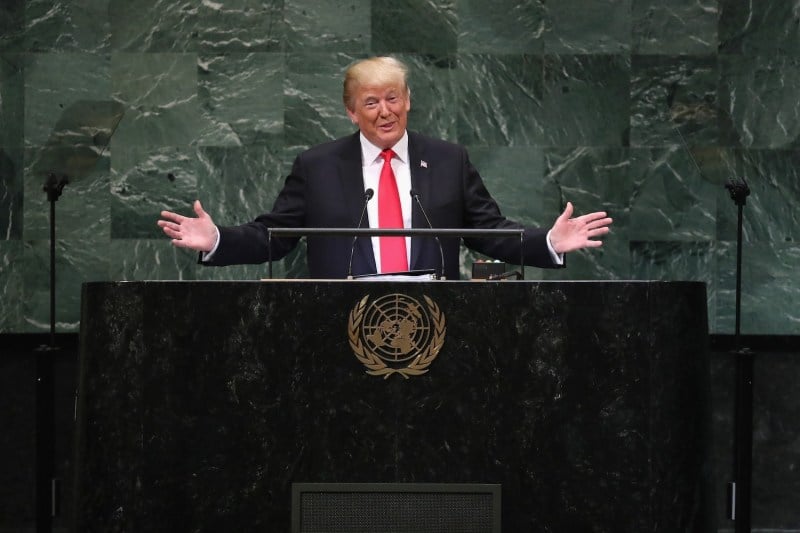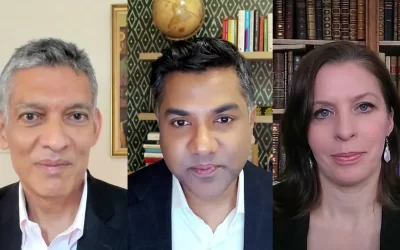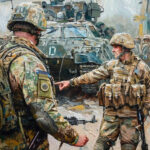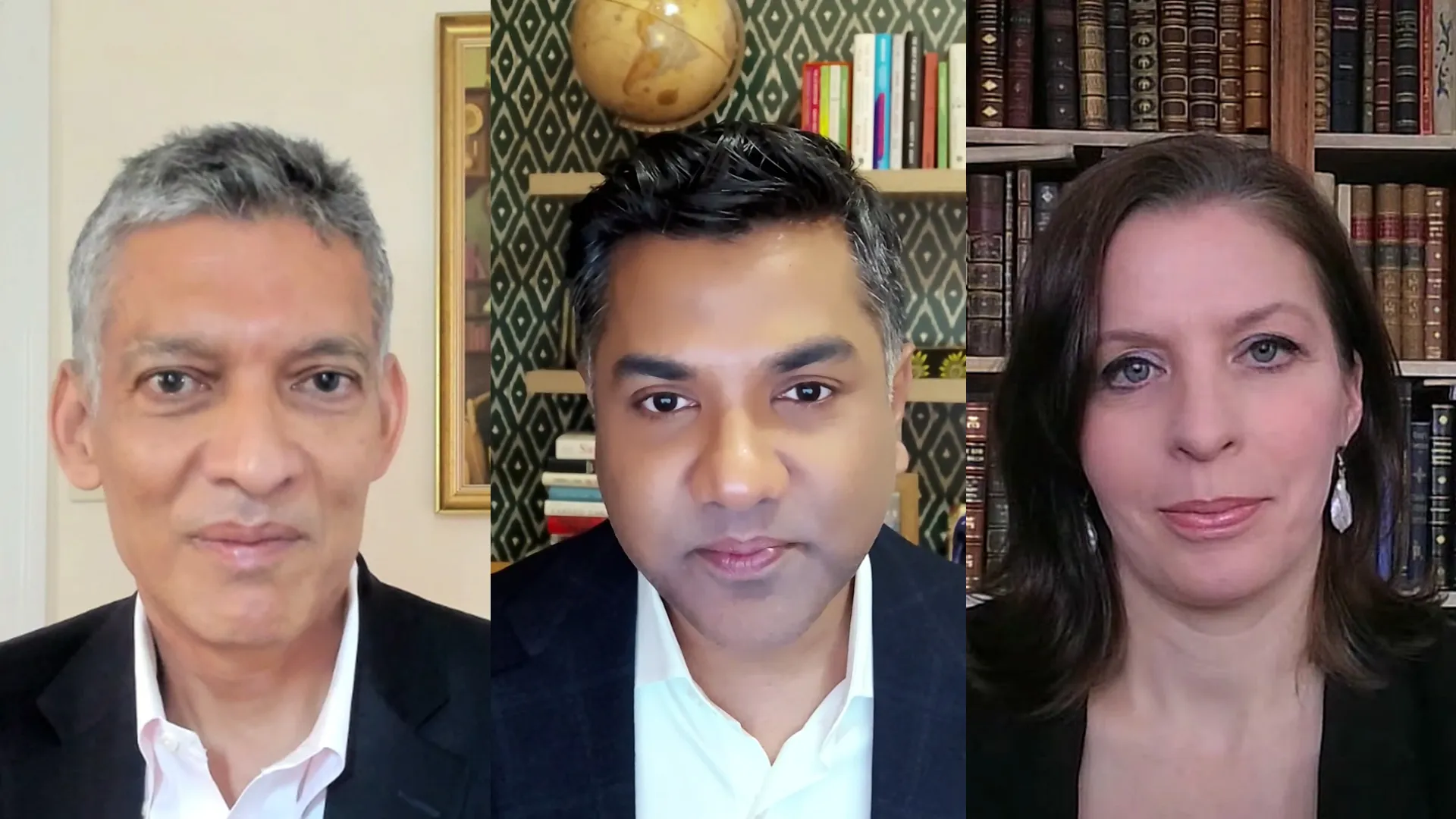Trump Is Trying to Remake the United Nations

Trump Is Trying to Remake the United Nations
Washington has signaled that it wants the international body to focus on preserving peace, but it could be looking to rubber-stamp its bilateral priorities.
U.S. President Donald Trump addresses the 73rd session of the United Nations General Assembly in New York City on Sept. 25, 2018. John Moore/Getty Images
Members of the Trump administration have said that U.S. President Donald Trump believes the United Nations should refocus on its “founding purpose” of preserving international peace and security. It is not clear what the administration’s appeal to the U.N.’s original ideals means in policy terms. Even the world organization’s proponents agree that after debilitating debates over the conflicts in Ukraine and Gaza, the Security Council and the overall U.N. system are in a bad state. The administration has emphasized what it does not like about the U.N., quitting or defunding multilateral arrangements on issues ranging from health to human rights. It has also announced a full review of all U.S. multilateral commitments and treaties, which include the U.N. Charter. But Washington has offered little detail about what Trump’s vision of a peace-focused U.N. would look like.
Last week, Washington nonetheless gave a pretty strong hint about how it sees the U.N. as a potential vehicle for framing big-power dealmaking and sidelining smaller states. It showed its hand on the third anniversary of Russia’s all-out aggression against Ukraine. Kyiv and its European allies aimed to mark this with a U.N. General Assembly resolution that condemned Moscow and reaffirmed Ukraine’s territorial integrity. The previous administration, under former President Joe Biden, had lobbied for similar texts.
Members of the Trump administration have said that U.S. President Donald Trump believes the United Nations should refocus on its “founding purpose” of preserving international peace and security. It is not clear what the administration’s appeal to the U.N.’s original ideals means in policy terms. Even the world organization’s proponents agree that after debilitating debates over the conflicts in Ukraine and Gaza, the Security Council and the overall U.N. system are in a bad state. The administration has emphasized what it does not like about the U.N., quitting or defunding multilateral arrangements on issues ranging from health to human rights. It has also announced a full review of all U.S. multilateral commitments and treaties, which include the U.N. Charter. But Washington has offered little detail about what Trump’s vision of a peace-focused U.N. would look like.
Last week, Washington nonetheless gave a pretty strong hint about how it sees the U.N. as a potential vehicle for framing big-power dealmaking and sidelining smaller states. It showed its hand on the third anniversary of Russia’s all-out aggression against Ukraine. Kyiv and its European allies aimed to mark this with a U.N. General Assembly resolution that condemned Moscow and reaffirmed Ukraine’s territorial integrity. The previous administration, under former President Joe Biden, had lobbied for similar texts.
In line with its policy of reconciliation with Moscow, by contrast, Trump’s team pressed Ukraine to withdraw its text—which President Volodymyr Zelensky refused to do—and tabled resolutions of its own in both the General Assembly and Security Council that dispensed with all criticism of Russia, made no mention of Ukraine’s sovereign rights as a U.N. member, and called for a rapid peace deal. China and Russia joined the United States to vote through the Security Council version of the text, although the United Kingdom, France, and the three other European members of the body abstained on it (the Europeans had more luck inserting references to Ukraine’s basic rights into the General Assembly version).
This was not only a break with the Biden administration’s approach to the U.N. but also the basic pattern of U.N. politics in the post-Cold War era. France, the U.K., and the United States have always had their differences in New York—most painfully over Iraq in 2003 and most recently over Gaza—but they have usually hung together on the most important votes. By contrast, China and Russia have coordinated increasingly closely in recent years, even if Chinese officials are usually less assertive than their counterparts. Russian officials have long felt that the United States has not treated them with the respect they deserve as a major power and veto wielder in the Security Council.
In trying to forge a compromise with Russia last week, the Trump administration arguably did pay homage to the founding logic of the U.N. system. For all its lip service to sovereign equality, the world organization is, by design, hierarchical: It invests a high level of institutional authority in a small clique of major powers. Former President Franklin D. Roosevelt, planning for the U.N. during World War II, imagined that the United States, Russia, the U.K., and China would use the Security Council as a framework to police the world (France was belatedly added to the list at the U.K.’s behest). The U.N. has rarely served that purpose, but it occasionally gave Moscow and Washington a space to help ease crises during the Cold War—sometimes at the expense of London and Paris.
During the Cold War, the Eisenhower administration aligned with Russia at the U.N. to pressure the U.K. and France to end their 1956 intervention in the Suez Crisis. During the 1973 Yom Kippur War, which threatened to spark a superpower war in the Middle East, U.S. Secretary of State Henry Kissinger flew to Moscow and hammered out the terms of a U.N. cease-fire resolution with the Soviet leadership (always maneuvering, Kissinger then advised the Israeli leadership it didn’t implement the cease-fire immediately). As the Cold War ended, the Soviets and the United States turned to U.N. peacekeepers and mediators to help untangle their proxy wars in the so-called third world. As recently as 2012, the Obama administration and Russia lowered the risk of a confrontation over the Syrian regime’s use of chemical weapons on its own people through a U.N. resolution on dismantling Damascus’s chemical arsenal. French politicians and generals, who had wanted to strike Syria, fumed.
In recent years, experts on the Security Council have fretted that decision-makers in both Washington and Moscow have forgotten the body’s value as a safety valve in moments of crisis. As Bruce Jones of the Brookings Institution noted in a paper last year, the post-Cold War generation of diplomats and U.N.-watchers have tended to forget how it can provide a “guardrail against great power escalation.” Following Russia’s invasion of Ukraine in 2022, the permanent members of the Security Council have continued to work together grudgingly on other files—although Russia has been increasingly willing to use its veto over issues like monitoring sanctions on North Korea—but nobody has turned to it as a platform for serious de-escalation.
At first glance, the Trump administration’s gambit over Ukraine last week may look like an attempt to refresh the U.N. as a big-power de-escalation mechanism, but it wasn’t that significant. The United States’ Security Council resolution was insubstantial—just 63 words long—and essentially justified the Trump administration’s preexisting bet on outreach to Russia. Unlike Washington-Moscow bargains over the Middle East during the Cold War, it provided for no concrete stabilization mechanisms, such as peacekeeping forces, or even established a U.N. mechanism to follow up. There are rumors that mid-level officials cooked up the whole escapade at short notice. This was big-power diplomacy lite: an opportunity for the United States and Russia to signal a new disposition toward one another without making any real commitments.
European diplomats are still worried that Washington could present them with further, and weightier, dilemmas over Ukraine at the U.N. The most troubling scenario would arise if the United States and Russia do hammer out a cease-fire deal on terms that Kyiv and its regional allies cannot swallow. Russia could bring a resolution endorsing the bargain to the Security Council—as it asked the council to back the controversial Minsk 2 bargain in 2015—and Washington would back it. In a worst case, the U.K. and France might seriously ponder using their vetoes on such a text (it appears that the idea of a veto on last week’s text only got a very token hearing in the British and French missions in New York). That would lead to a greater trans-Atlantic breakdown.
If the U.S. posture is a source of discomfort to two of its key NATO allies, it is also a potential worry for the other veto power, China. Chinese diplomats seemed bemused by the Trump team’s behavior in New York last week, even if they voted for the U.S. Security Council resolution. It is not clear that the Trump administration’s interest in engaging with Russia at the U.N. also applies to China, which it considers a more threatening rival. The first Trump administration did negotiate fruitfully with Beijing over U.N. sanctions on North Korea, but it also used the Security Council as a platform to bash the Chinese over COVID-19 in 2020. Over the last month, the United States has been blocking a proposal by China that states it should act as the council “penholder” (or main drafter) on texts relating to Afghanistan. This appears to be driven more by a broad desire to contain Beijing’s influence in the U.N. system than differences over how to address Afghan problems. Chinese officials may worry that the United States aims to keep them in check at the U.N. while trying to draw Russia away from them.
The wider U.N. membership also has mixed feelings over the new U.S. posture. There have been numerous stories of U.S. officials using extremely harsh threats as they lobbied other states not to back Kyiv and the Europeans last week. But some diplomats from the global south also welcome Washington’s new direction of travel. There is a widespread feeling among non-Western officials in New York that the Biden administration’s strong line toward Russia at the U.N. has done nothing to end the war and made it harder to talk about other multilateral priorities such as global development. While they worry about the Trump administration’s overall allergy to international cooperation, they are at least willing to see if its new approach to Moscow helps.
Most states will not take such a benign view if the administration tries to railroad some of its other priorities—such as its ideas for a takeover of Gaza—through the Security Council. Last week’s spat over Ukraine may only be a prelude to much greater rows over Israel and the Palestinians at the U.N. And thoughtful diplomats see Washington’s willingness to dump some of the basic principles of international law—like territorial integrity and nonaggression—when referring to Ukraine as a worrying sign about how it will address other crises.
There is ultimately a difference between the big powers using the Security Council as a space for short-term signaling over crises—which is all the United States did last week—and treating the U.N. as a framework for sustainable peacemaking. For the global organization to serve the latter function, it is necessary to take at least some of its guiding principles seriously and try to involve broader coalitions of states in real diplomacy. It is not clear whether the Trump administration sees the U.N. as anything more than somewhere to rubber stamp its bilateral diplomacy with Moscow. Even a very cynical reading of the U.N.’s “founding purpose” suggests it should aim for more than that.
More from Foreign Policy
-

Samuel Huntington holds his hand to his chin while sitting in an office. Samuel Huntington Is Getting His Revenge
The idea of a global “clash of civilizations” wasn’t wrong—it was just premature.
-

U.S. President Donald Trump meets with Ukrainian President Volodymyr Zelensky at the White House on Feb. 28. The Perils of a Reality TV Presidency
The Trump-Zelensky shouting match is a reminder that international diplomacy was never meant to be carried out in front of billions of eyes.
-

A Ukrainian serviceman trains in the woods near the frontline in Ukraine. Three Years On, What’s Next for Europe and Ukraine?
Nine thinkers on the bombshells coming out of Washington.
-

Donald Trump is seen inside a helicopter at night looking down at a cell phone Trump’s New Map
America’s first post-literate president has only geography to fall back on.










Join the Conversation
Commenting on this and other recent articles is just one benefit of a Foreign Policy subscription.
Already a subscriber?
.
Subscribe
Subscribe
View Comments
Join the Conversation
Join the conversation on this and other recent Foreign Policy articles when you subscribe now.
Subscribe
Subscribe
Not your account?
View Comments
Join the Conversation
Please follow our comment guidelines, stay on topic, and be civil, courteous, and respectful of others’ beliefs.
Change your username |
Log out
Change your username:
CANCEL
Confirm your username to get started.
The default username below has been generated using the first name and last initial on your FP subscriber account. Usernames may be updated at any time and must not contain inappropriate or offensive language.